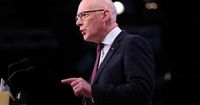At the Scottish National Party (SNP) conference in Aberdeen on October 11, 2025, First Minister John Swinney made a bold promise: the SNP would "win big" at next year's Holyrood election and, if successful, deliver a second referendum on Scottish independence. The announcement, delivered with conviction to party members and the media, marked a pivotal moment in Scotland's ongoing constitutional debate—one that has seen passions flare and strategies contested from every corner of the political spectrum.
Swinney’s plan, now officially endorsed by SNP members, is straightforward in its ambition. If the party secures a majority of seats in the Scottish Parliament in the May 2026 election, the Scottish Government will treat this as a mandate to begin negotiations with Westminster for a second independence vote. "The precedent is clear. When the SNP wins a majority, we deliver a referendum. We did it in 2011 and we need to do it in 2026," Swinney told the conference, referencing the historic 2011 election that led to the 2014 independence referendum.
But the road to consensus within the independence movement has been anything but smooth. Grassroots members and party activists tabled amendments to Swinney’s resolution, arguing for alternative paths to independence. One notable proposal sought to treat the 2026 Holyrood election as a de facto referendum, with a mandate for independence declared if more than 50% of votes on the regional list went to pro-independence parties such as the Scottish Greens or Alba. Derek Pretswell, an SNP member from Oban and Lorn, described this as a "fair mechanism" to achieve majority support without needing UK government approval.
Swinney, however, rejected the idea of tinkering at the margins. "I did not take on the leadership of this party to make a difference at the margins or to make a bit of progress towards independence or even pave the way for the next generation to win it," he declared. "No, I took the leadership to deliver independence and that’s exactly what I’m going to do for Scotland." He implored delegates to have faith in his strategy, insisting that only a clear majority for the SNP would provide the unambiguous mandate necessary to press Westminster for a referendum.
The party’s depute leader, Keith Brown, made clear just how much was riding on this strategy. "John Swinney has staked his premiership on winning independence," Brown said, commending Swinney’s resolve. When pressed by The Herald about the consequences of falling short, Brown acknowledged, "He’s staked his premiership on the idea of winning independence. I’m not denying that, but he’s doing it from a position of strength." The message was unmistakable: Swinney’s leadership—and perhaps the future direction of the SNP—hinges on the outcome of the 2026 election.
In the conference hall, Swinney’s pledge to "break the logjam" on Scotland’s constitutional future was met with a standing ovation. Yet, he was careful to keep his cards close to his chest regarding the specifics of his post-election tactics. "Nobody knows the tactics I’m going to deploy if we get 65 seats in the Scottish Parliament. So keep watching because Scotland is on the journey to independence," he teased, fueling speculation about the party’s next moves should Westminster remain unyielding.
Despite the overwhelming support for Swinney’s plan among party members, the debate exposed persistent divisions within the independence movement. Graeme McCormick, a prominent activist who had considered running for party leadership, warned of declining party membership and a lack of inspiration among the grassroots. "There isn’t a branch that hasn’t suffered significant reductions," he lamented, urging candidates to prioritize loyalty to the Scottish people over party hierarchy. McCormick’s plea was clear: only a decisive, popular mandate could reinvigorate the movement and restore confidence in the SNP’s vision.
Other amendments to the independence strategy were accepted by the leadership, including a commitment that an independent Scotland would seek to rejoin the European Union and a pledge to work constructively with other parties. These concessions signaled a willingness to build broader coalitions, even as the party remained firm on the centrality of a majority SNP victory as the trigger for renewed negotiations with Westminster.
Yet, as the SNP rallied around its leader, opposition parties wasted no time in launching fierce critiques. Scottish Conservative Deputy Leader Rachael Hamilton dismissed the debate as "fantasy," accusing the SNP of "squabbling like Nats in a sack over which version of this fantasy to back." She added, "The SNP leader may be proud of selling a pig in a poke to his own supporters, but he and his party have lost all credibility with their renewed drive for an unwanted referendum." Hamilton’s remarks captured the skepticism—if not outright hostility—of unionist parties toward the independence project.
Scottish Labour Constitution Spokesperson Neil Bibby was equally scathing, arguing that the SNP’s focus on independence came at the expense of urgent public service challenges. "One person dies from a drug overdose almost every seven hours in Scotland, one in six Scots is on an NHS waiting list, violence is rising in our schools, and a housing emergency is causing misery for families across the country—yet the SNP has no answers," Bibby said. He called the independence strategy a "waste of time" and urged voters to seize the 2026 election as a chance to "remove the SNP from power and elect a Scottish Labour government that will end the chaos and take Scotland in a new direction."
Even within the wider independence movement, there was dissent. Alba Party Leader Kenny MacAskill, himself a former SNP minister, described the vote as a "missed opportunity to unite the independence movement and pursue a clear, credible and popular strategy to seek and achieve a mandate for independence." MacAskill warned that the SNP’s approach "handed a veto to Westminster" and prioritized party interests over the broader cause.
For Swinney and his supporters, however, the path forward is clear—even if fraught with uncertainty. By tying his leadership to the goal of delivering independence, Swinney has raised the stakes for both himself and his party. The strategy’s reliance on a majority SNP victory echoes the precedent set in 2011, but the political landscape has shifted considerably since then. With UK Labour leader Sir Keir Starmer having stated he "could not imagine" a second independence referendum during his premiership, the constitutional standoff is likely to persist regardless of the Holyrood outcome.
Still, as Swinney put it, "People are relying on us. They need us to be ready to fight and to win." Whether this bold approach will galvanize the SNP’s base or provoke further division remains to be seen. What is certain is that Scotland’s constitutional question is far from settled—and the coming months promise to be some of the most consequential in recent memory.


